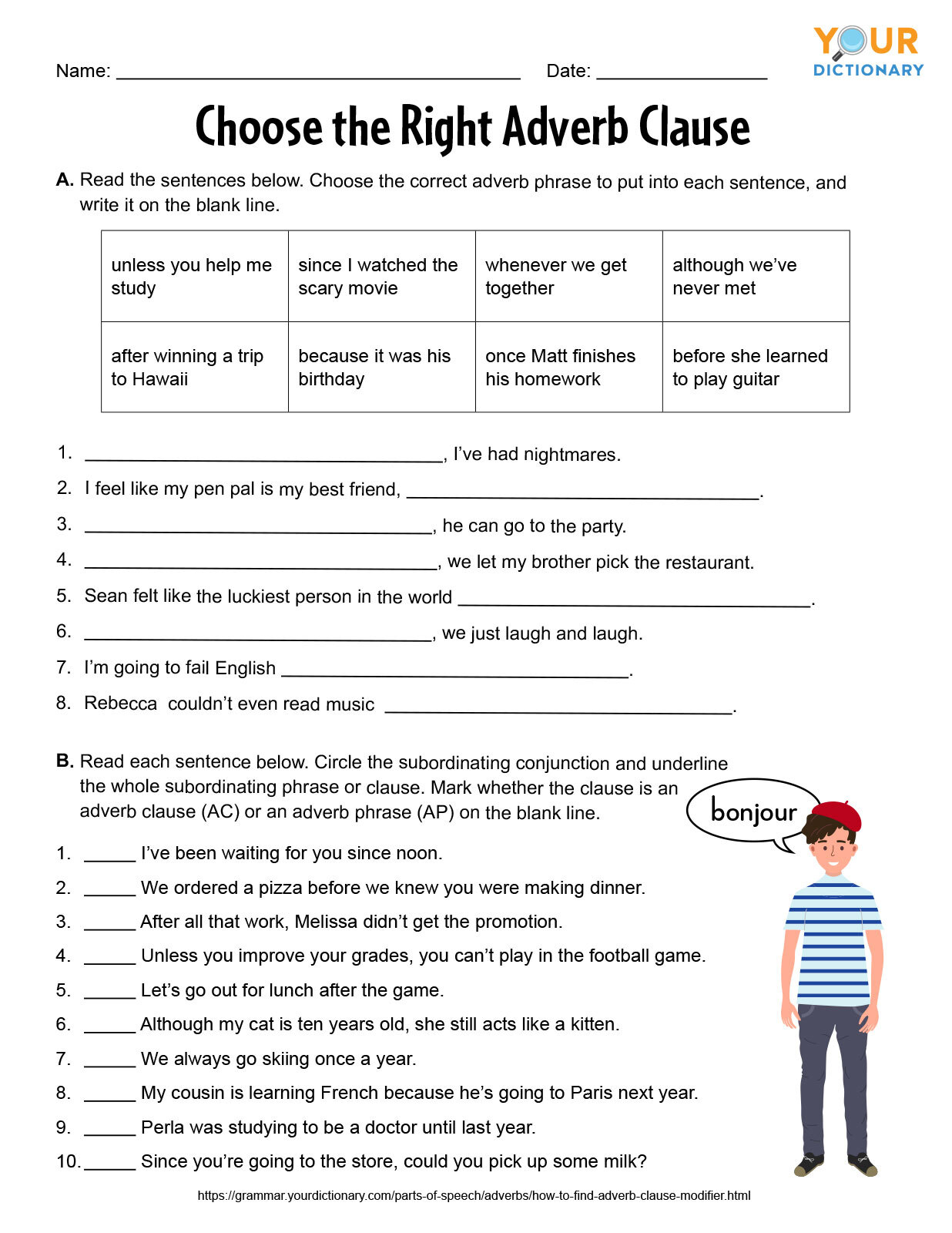Adverb Clauses Worksheets – Adverbs identify a verb, an adjective, or another adjective. Adverbs can be used to express when, where and how something was done. They are typically used in conjunction with the verb or adjective that they modify.
These are only a few examples.
He ran quickly.
She sang beautifully.
They can fluently speak English.
There are a variety of ways to create adjectives. As you can see, there are multiple ways to create an adjective. You can also create additional adverbs by using different words.
He drives slowly.
He arrived at the right time.
Adverbs are usually placed at the beginning or the end of an expression. The intention behind the adjective will determine the place it is placed.
As you can see, adverbs which modify verbs should be placed after the verb. Adverbs that modify adjectives as well as other adjectivals should be put in front of the adjective or modifier that they modify.
For example:
He is a slow driver. (incorrect)
He is a slow car. (correct)
He drives slowly. (correct)
They showed up promptly. (correct)
They showed up promptly. (incorrect)
Let’s talk about Adverbs. These worksheets can be used to help you learn how to use adverbs inside sentences. The worksheets are split into three parts: the identification and use of adverbs and creating adverbs.
Review a variety of sentences and identify the adverbs that are in each sentence. This first section will help you identify Adverbs. It is possible to try using Adverbs for adjectives and verbs in the next section. The third section will focus on making Adverbs. This section will teach you how adjectives are transformed into adverbs.
What are you putting off? Take out your pencil and look at these adverb worksheets.
Worksheets on Adverbs: Types, and Uses
An adverb can be described as a word that refers to a verb, an adjective, or another word. Adverbs inform you about what was said you need to know about where, when, and how the action was carried out. Adverbs, for example, are often placed after the sentence.
Slowly, he walked through the room.
For instance, many adverbs can be created by adding -ly after an adjective.
Adjective “Slow”
Adverb: slowly
Adjective: quick
Adverb: quickly
Adjective: hard
Adverb: Hard
An adverb can either be a single word, or a multi-word adverb. A good example of a one-word adjectival is the –ly form.
He walked slowly around the space.
Multi-word adverbs comprise of several words like:
He moved slowly throughout the room.
These are some common multi-word adjectives:
adverb + adverb: quite slowly, extremely quickly
Adverb + adjective Very hot, very cool
Preposition + adjectival delay, ahead
There’s two types of adjectives.
1. Adverbs used to describe methods
The fashion adjectives explain how something is done. Here’s an example of how:
He moved slowly throughout the room.
This sentence slowly exposes his actions.
These are only two examples of adjectives that describe manner.
Slowly, quickly, quietly and loudly and slowly
2. Adverbs that are related to the location
Place adverbs tell us the place where something was accomplished. For instance:
He moved around the room.
The adverb at the end of this sentence indicates the direction the person has walking.
Two examples of adverbs that refer to places.
Outside the house, upstairs and downstairs.
Adverbs can also describe frequency and time. For example, adverbs of time are used to indicate that something has been completed.
He was slow to move around the room.
The sentence in question uses the word adjective slow.
Adverb Worksheets – Tips and tricks
Adverbs are words that alter an adjective, verb, or another adverb. These worksheets can be used to help students understand the various ways to use Adverbs. These are some tips and tricks that choice support you get the most benefit of your worksheets on adverbs.
1. You can choose from a variety of sentence forms.
Adverbs can be used in many different types of sentences. Make sure you incorporate it when you are working on your worksheets. Simple sentences can be mixed with complex sentences or even questions. This will allow students to discover the many applications of adjectival terms.
2. Highlight with the adjectival
When you create worksheets for your students, make sure you highlight the adverbs that are in each sentence. This will make it simpler and more fun for your students. You can highlight the adverbs using one color or use a different color to symbolize each sentence.
3. Students are encouraged to write their own sentences.
Students should be able fill in the blanks on worksheets, as well as write sentences with adverbs. They will be able better understand the writing of adverbs.
FAQs about Adverb Worksheets
1. What are adverbs?
An adverb describes an adjective or verb or any other word. Adverbs are utilized to specify when and how something happens. They usually end with”-ly”
2. There are four primary types of adverbs that you can use.
There are four types.
3. How can I use adverbs in my writing?
Adverbs can serve as adjectives, or as verbs. Adverbs can help improve your writing and more descriptive.
4. What are some popular adjectives you’ve used?
The most frequent adverbs are: rapidly or slowly; severely, well; hard, soft, late and early not always, but sometimes, and often.






